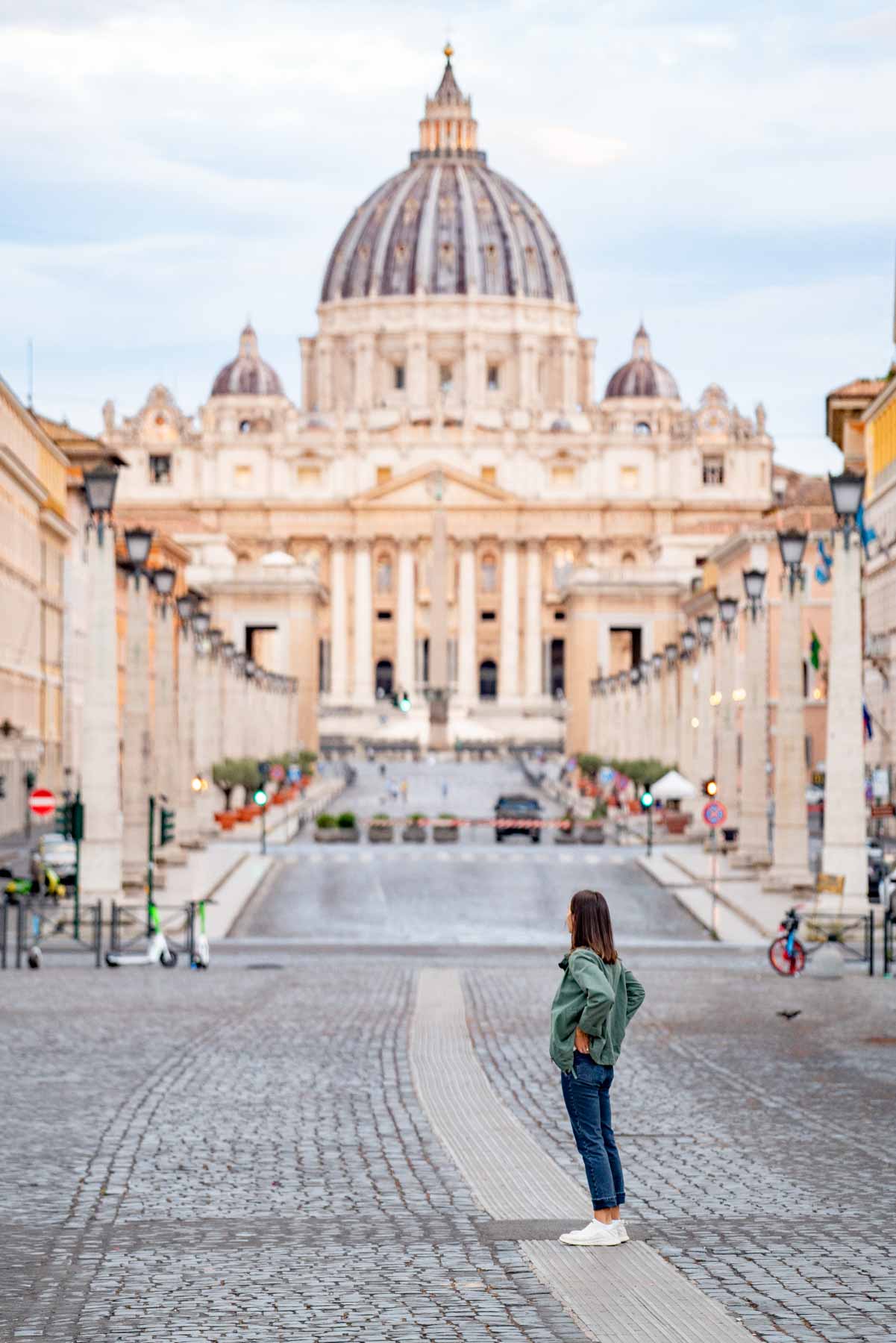
One of my favorite things about visiting the Eternal City is getting a chance to explore the beautiful churches in Rome. Longtime readers know that I have a soft spot for Rome, I lived in the city for a summer and that only cemented by adoration of the historic city.
In Rome, churches hold immense significance not just for their religious functions but also for breathtaking architecture and immense history. However, it’s very easy to get church fatigue after a few days (the churches start to look the same.
To set you up for success, I’d like to share my list of the prettiest churches in Rome, hopefully this list helps you narrow down the places worth a visit. Let’s dive in!
How to (Respectfully) Visit Churches in Rome
The churches in Rome are houses of worship, therefore, respect is paramount. Here’s a few quick things to keep in mind before visiting.
Dress Appropriately: Many churches, including St. Peter’s Basilica, have strict dress codes to honor the sacred nature of the experience. Ensure your shoulders and knees are covered. Avoid wearing hats inside and opt for modest, respectful clothing that reflects your respect for the culture.
Silence is Golden: Churches are places of worship and reflection, so it’s important to speak softly if you need to communicate, better still, soak in the tranquility through silence. Make sure to silence your cell phone to avoid disturbing others (it’s so easy to forget!).
Respect Worship Areas: While visitors are welcome to explore most areas of Rome’s churches, certain sections may be reserved for prayer or religious services. Look for signs indicating restricted areas, and avoid entering or taking photos in these spaces, especially during Mass or other religious ceremonies.
Most Beautiful Churches in Rome
(Table of Contents)
Must-Visit Rome Churches (Table of Contents)
- Most Beautiful Churches in Rome
- Basilica of Saint Peter in Chains
- Saint Peter’s Basilica
- Archbasilica of Saint John Lateran
- Church of St. Ignatius of Loyola
- Basilica of Our Lady in Trastevere
- Parish Basilica of Santa Maria del Popolo
- Basilica of St. Clement
- Basilica of Saint Sabina at the Aventine
- Church of St. Louis of the French
- Sant’Andrea della Valle
- Our Lady of the Conception of the Capuchins
- Basilica of the Holy Cross in Jerusalem
- Basilica of Saint Mary Major
- Important Churches in Rome (Post Summary)
- Map of the most beautiful churches in Rome
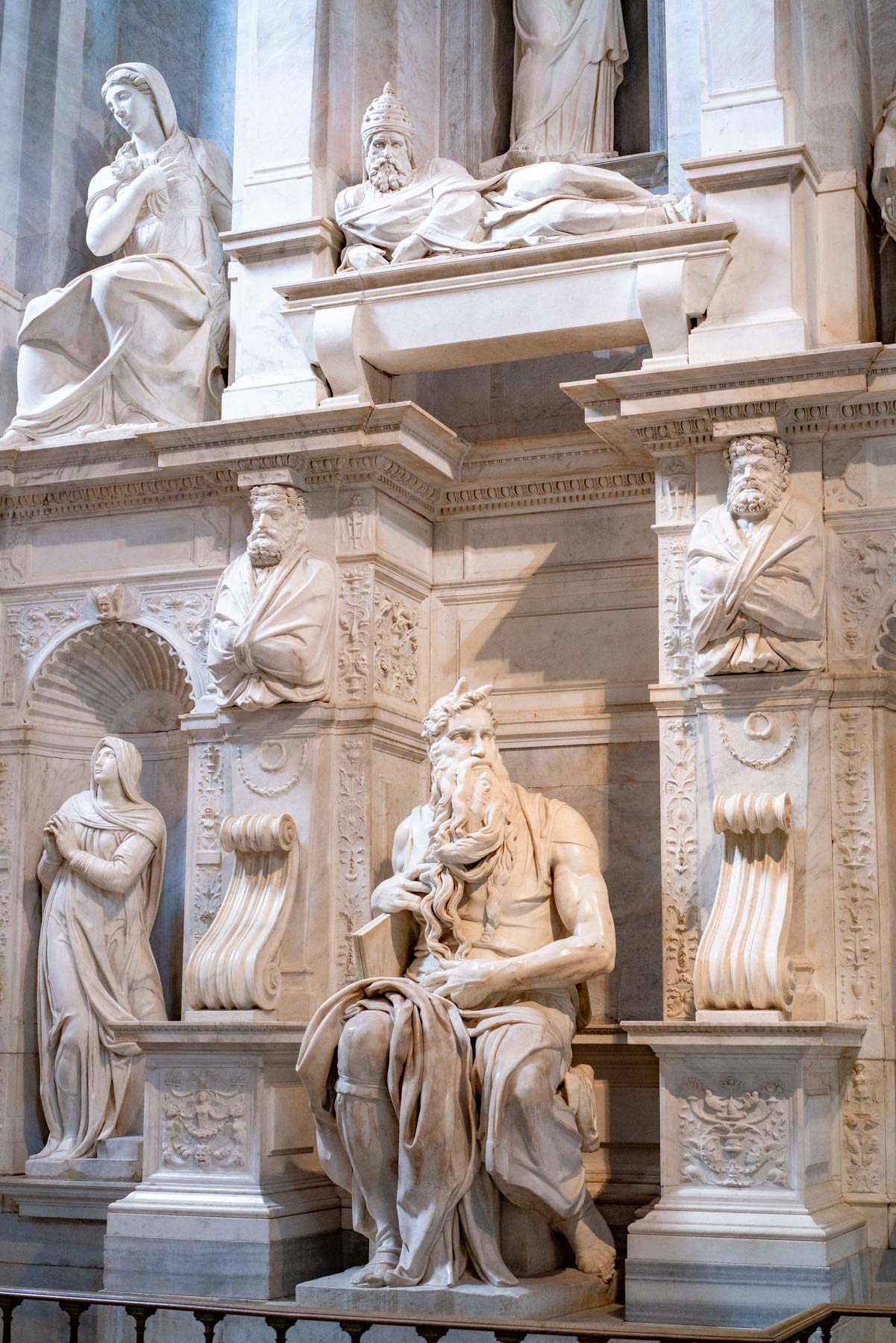
Basilica of Saint Peter in Chains
The Basilica of Saint Peter in Chains (San Pietro in Vincoli) is a hidden gem among Rome’s treasure trove of historic sites. The church is renowned not just for its spiritual significance but also for housing one of the world’s greatest sculptures: Michelangelo’s Moses.
Designed to be part of the tomb of Pope Julius II, this masterpiece of a statue alone is worth a detour. Michelangelo connections aside, the church was originally built to house the chains believed to have bound Saint Peter in Jerusalem.
The chains were a gift to Empress Eudoxia from her mother, who later bequeathed them to Pope Leo I. If you pop into the church, you can see the chains in a reliquary under the main altar in the basilica. As for the church? It feels more humble than most of the churches in Rome.
It’s beautiful, no doubt, but it doesn’t overwhelm with massive paints and gold details covering every square inch. It’s also less crowded than most of the pretty churches in Rome we came across, it offered a great reprieve from the crowds!
Address: Piazza di San Pietro in Vincoli, 4/a, 00184 Roma RM
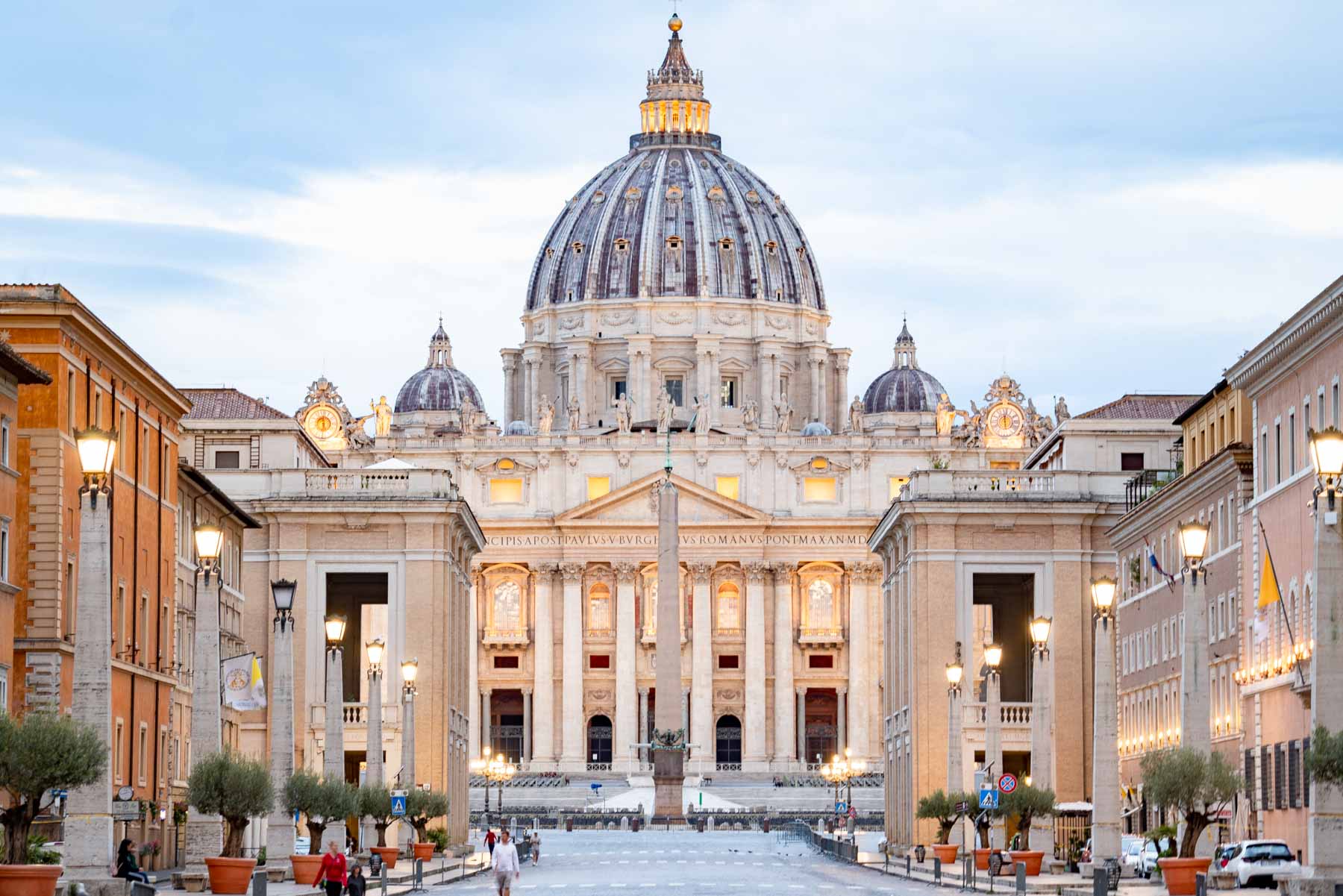
Saint Peter’s Basilica
Completed in 1626, Saint Peter’s Basilica was built atop the grave of Peter the Apostle, considered the first pope of Rome. The basilica is Rome’s crown jewel, which is saying a lot in a city as beautiful as Rome!
Conceived during the Renaissance, It was designed by a handful of notable architects and artists from the era, including Bramante, Michelangelo, and Bernini. Michelangelo’s dome, a marvel of engineering, soars above the Roman skyline, while St. Peter’s Square (designed by Bernini) gracefully welcomes visitors from around the world.
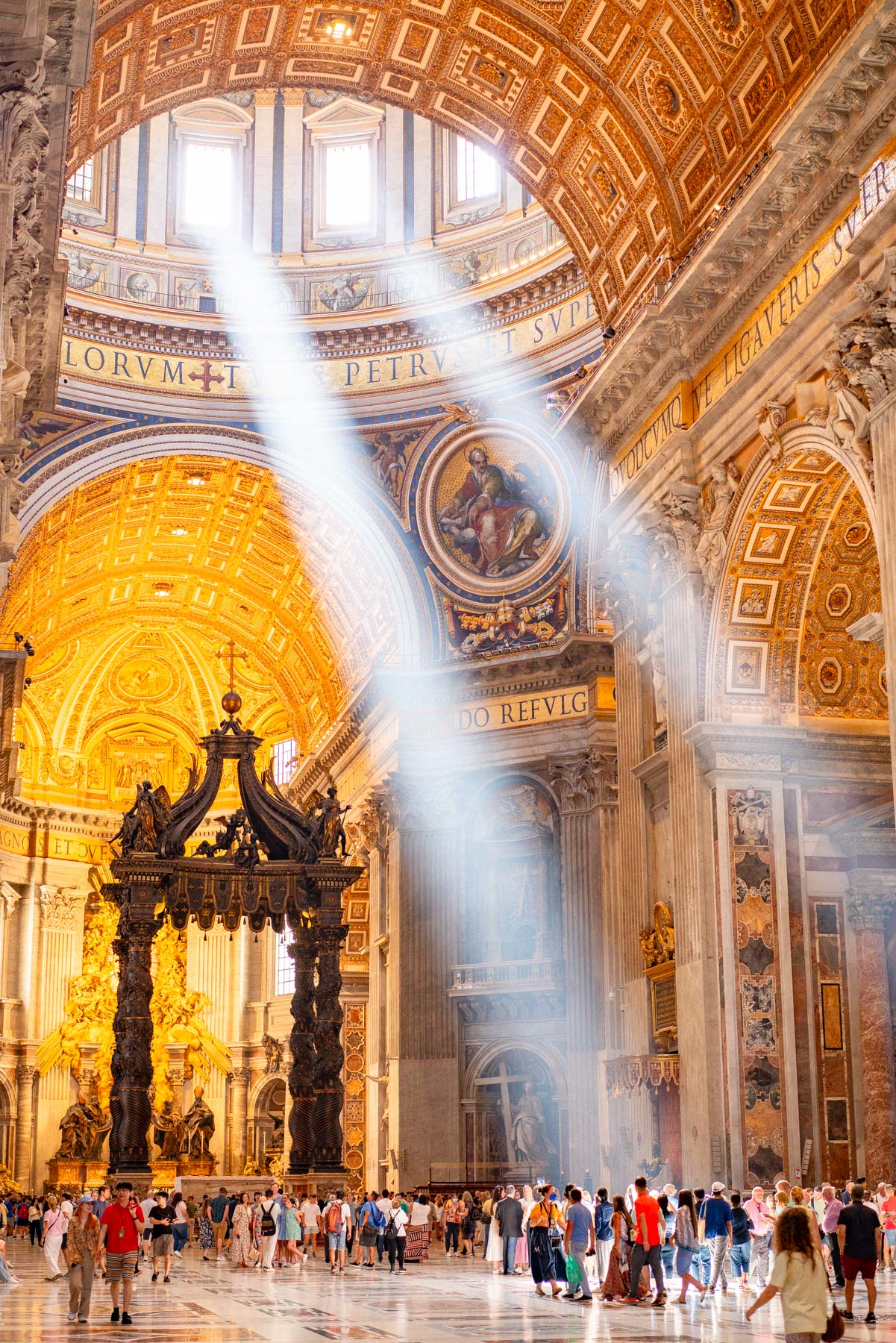
Inside, the basilica is adorned with incredible art that draws hordes of visitors. Most notable is Michelangelo’s poignant Pietà, a sculpture that captures the Virgin Mary’s sorrow at the death of Jesus. Every corner of St. Peter’s Basilica, from the lavish nave to gilded altar, reflects a legacy of faith, art and architecture.
There’s no denying that St. Peter’s Basilica is one of the most beautiful churches in Rome. It serves as a testament to divine inspiration and human ingenuity and leaves a lasting impression on all who visit.
Also, check out the crypt where the popes are buried, located right under the basilica. Most tourists don’t realize the area is open to the public. It’s a pity because it was one of the highlights for us while visiting the churches of Rome.
Helpful Tip: Try to visit Saint Peter’s Basilica after 4pm for the shortest wait times. We visited at 5pm and only stood in line for 15-minutes! If helpful, the church doors close at 7pm.

Archbasilica of Saint John Lateran
Here’s a fun fact for you: most folks think that St. Peter’s Basilica is the official seat of the pope, but it’s not. The Archbasilica of St. John Lateran is the official seat of the Bishop of Rome (AKA the pope).
Founded in 324, this is the oldest public church in Rome. It’s also the highest ranking basilica in Rome (outranking Saint Peter’s Basilica), holding the unique title of “archbasilica.”
Designed by Constantine the Great, it consists of a long nave with aisles off-shooting to the sides to form a cross from a bird’s-eye view. The church’s profound historic significance is properly reflected through the imposing facade, stunning architecture and lavish interior adorned with frescoes and mosaics.
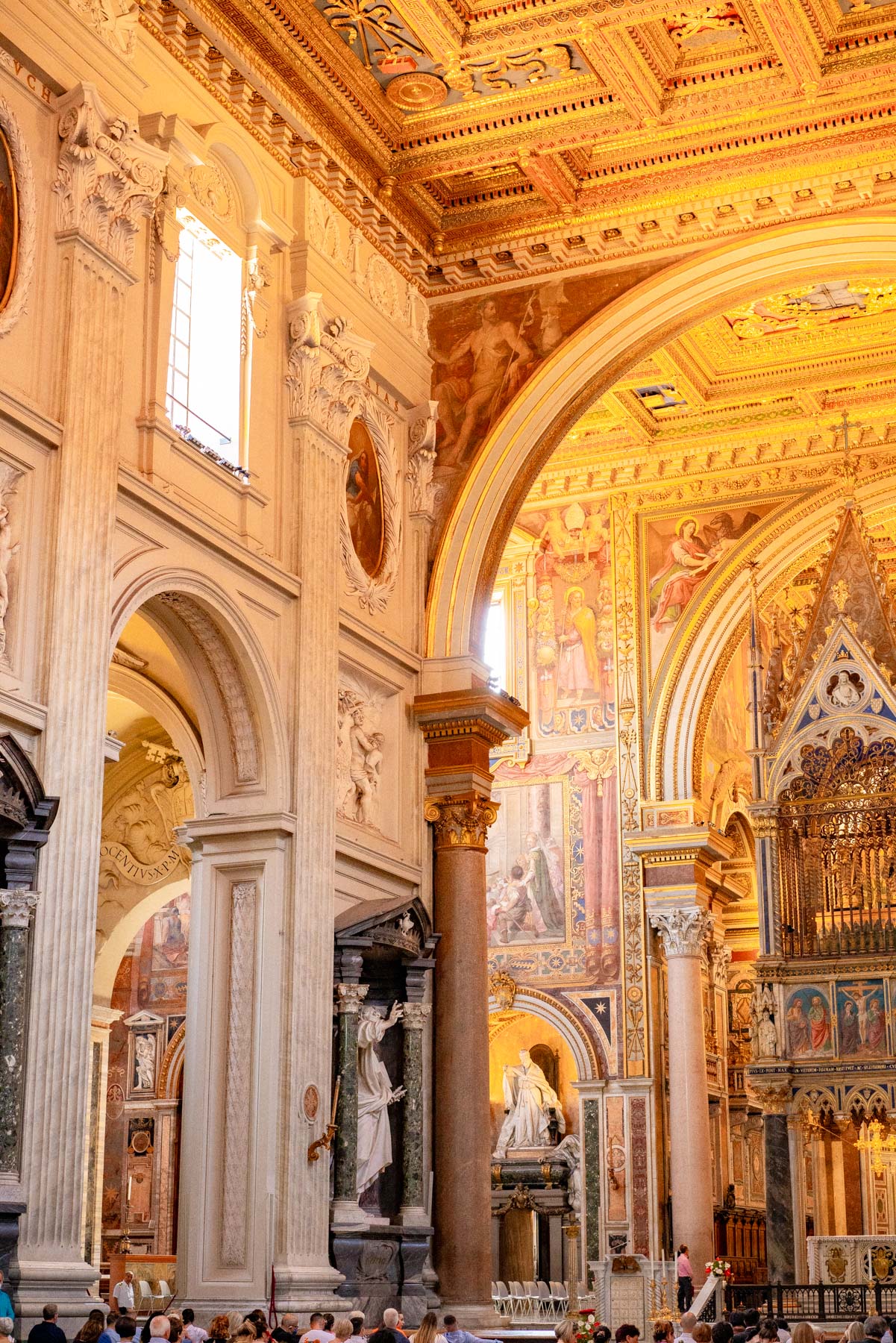
While visiting the church, take time to visit the adjacent buildings, too. The Lateran Palace served as the official residence of popes for almost a millennium, until the 15th century. It’s open for tours, if interested, check out the official website.
The biggest draw in the area is the Pontifical Sanctuary of the Holy Stairs, which is believed to house the Holy Steps that Jesus climbed on the day of his death sentence in the palace of Pontius Pilate.
During our visit, we watched people climb the 28 steps (must be done on knees), it seemed like a very emotion experience. Admission to the sanctuary is €3.50 per person.
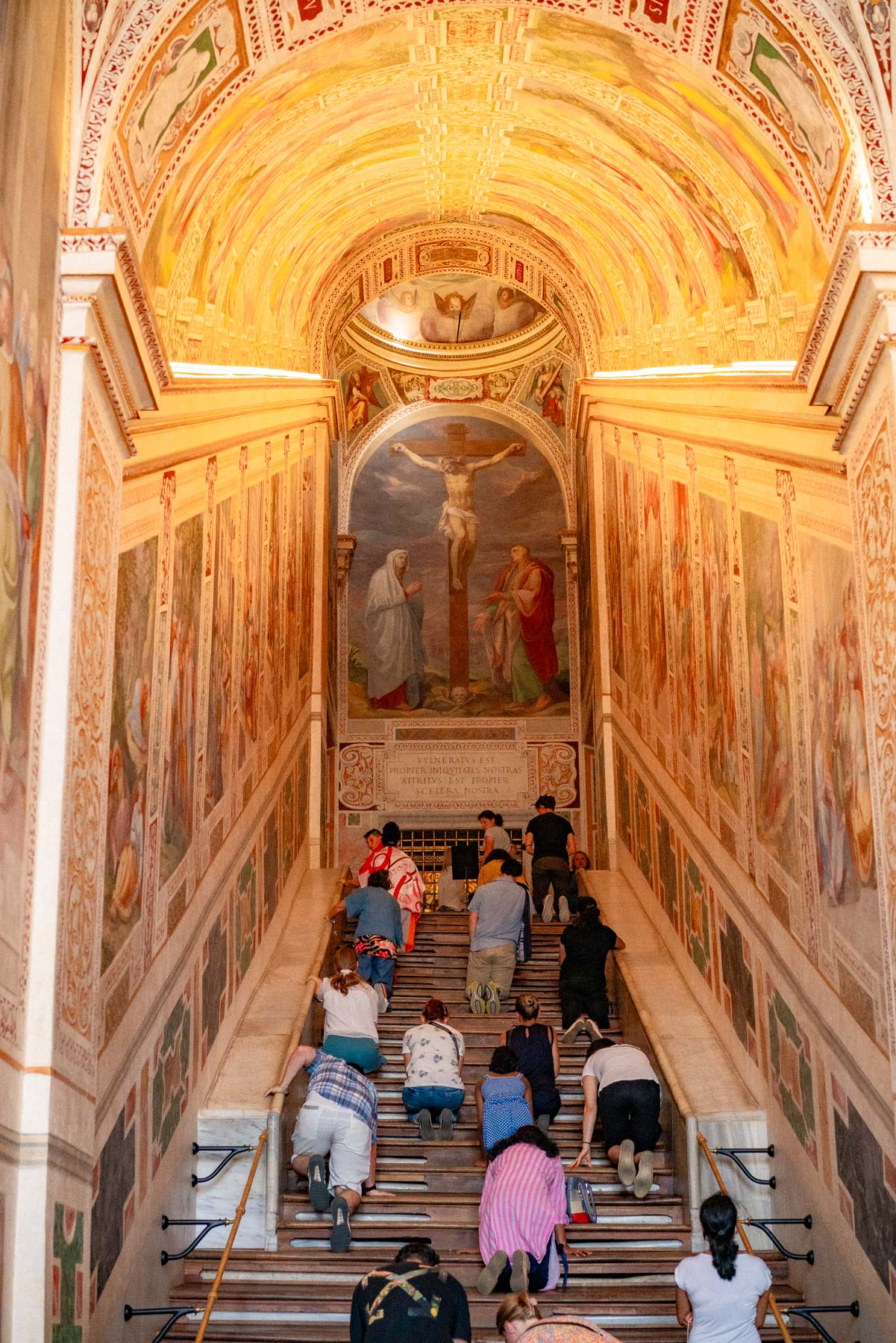
The significance of Saint John Lateran is unparalleled, which it why this is considered one of the most important churches in Rome and it’s hard to disagree with that.
Address: Piazza di S. Giovanni in Laterano, 4, 00184 Roma
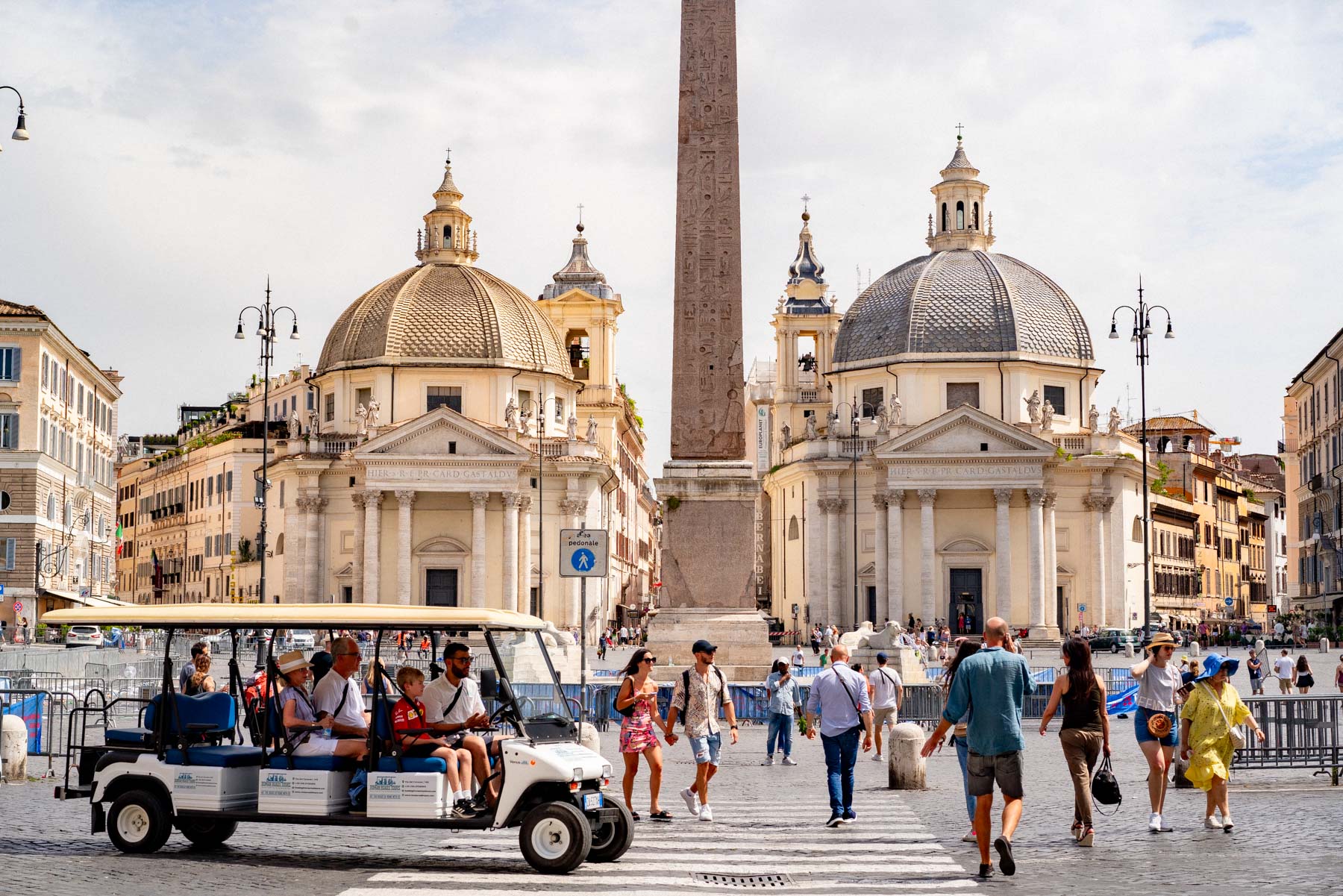
Santa Maria del Popolo
Santa Maria del Popolo is often overlooked by visitors because it’s a little removed from the downtown core. However, if you’re a museum nut, there’s a good chance you’ll be visiting the area en route to the Borghese Gallery (one of the best museums in Rome).
The Parish Basilica of Santa Maria del Popolo was originally built in the 11th century over Emperor Nero’s tomb. Christians believed the area to be cursed because Nero was manifested as the Antichrist. As such, the origins of the church are shrouded in myths and apprehension.
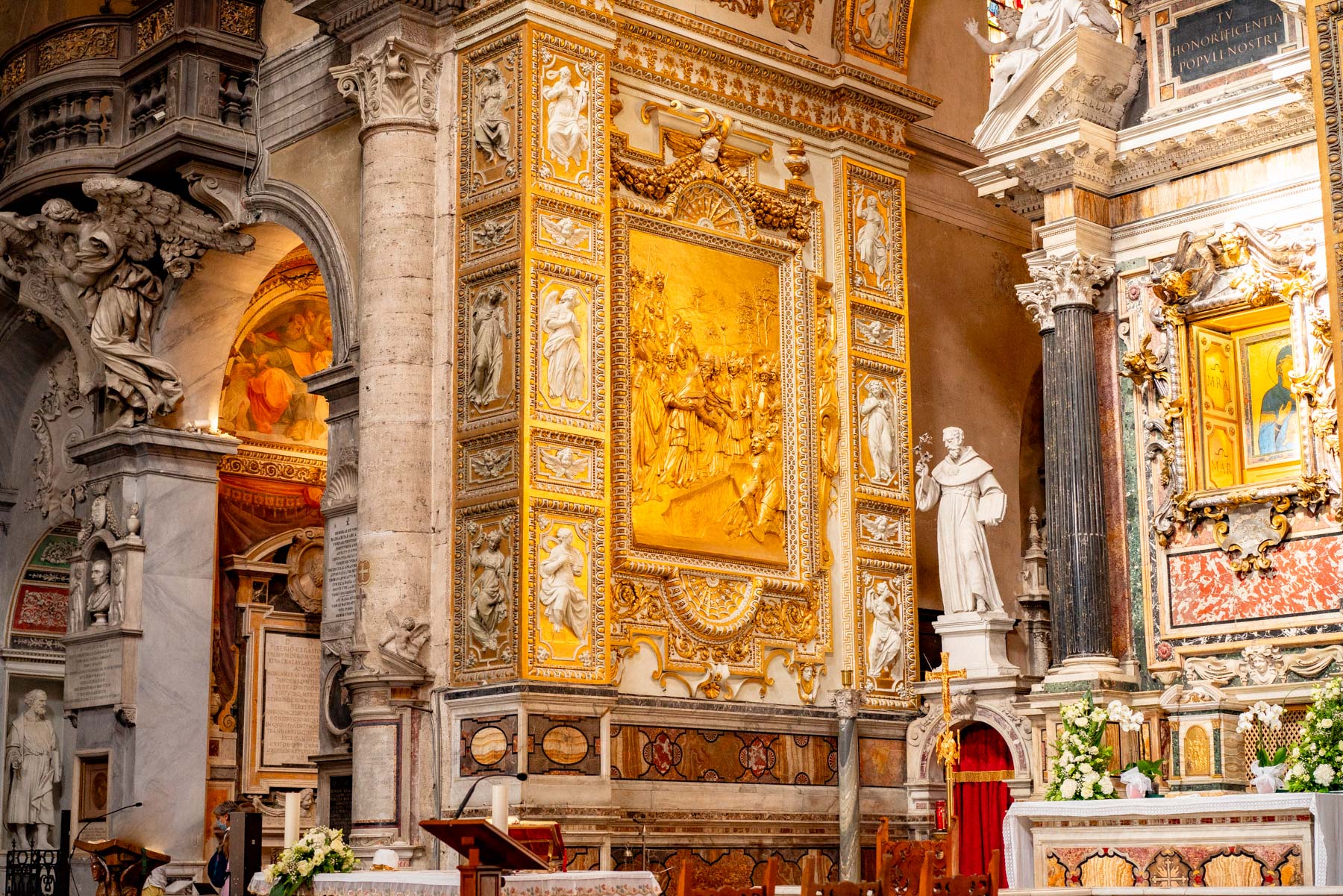
According to popular legend, after the Emperor’s suicide in 68 AD, his remains were interred within the family tomb located in what is now the Piazza del Popolo. Over the centuries, the area gained a sinister reputation, with locals convinced it was cursed and haunted by Nero’s malevolent spirit.
In response to these unsettling occurrences, Pope Paschal II commissioned the construction of a chapel dedicated to the Virgin Mary in 1099. This initial chapel was intended to exorcise the area of Nero’s negative influence.
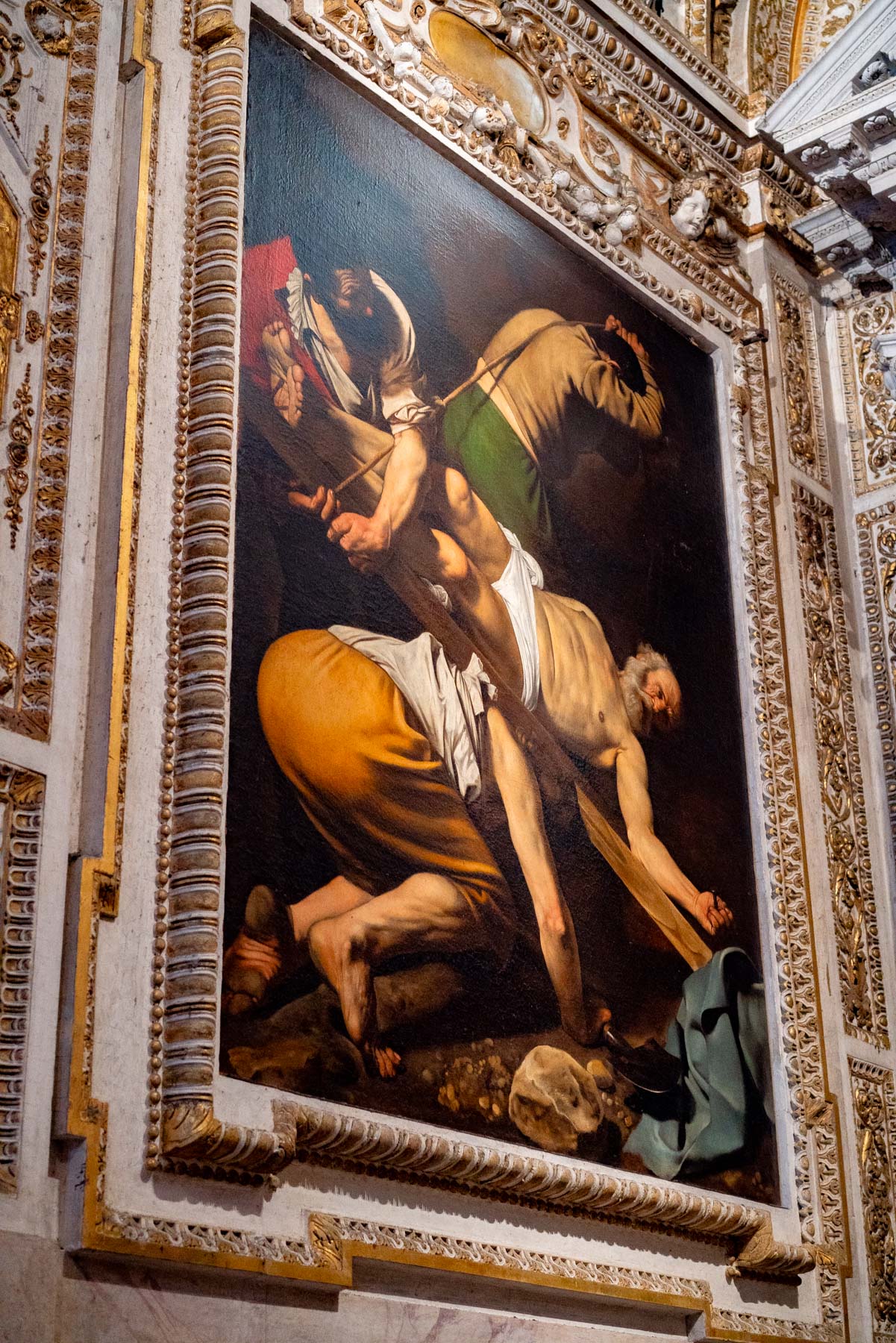
As the church transformed over time, it became know for housing an impressive artworks by Caravaggio, Raphael and Bernini. The basilica’s blend of myth, historical lore, architectural beauty and artistic masterpieces, makes Santa Maria del Popolo one of the most interesting churches in Rome, you won’t want to miss it!
Address: Piazza del Popolo, 12, 00187 Roma RM
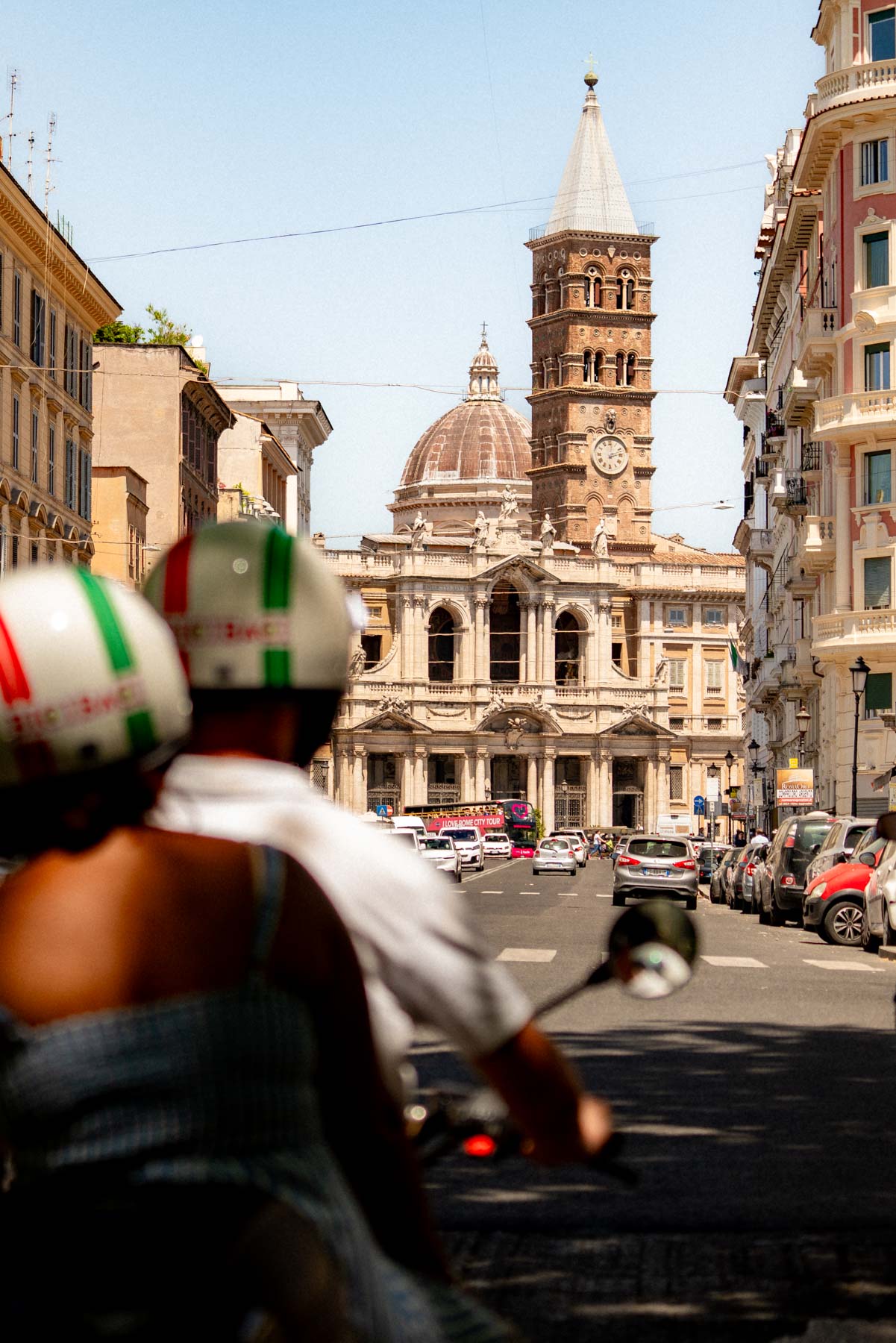
Santa Maria Maggiore
Santa Maria Maggiore is one of Rome’s four major basilicas and a true gem steeped in history and devotion. Founded in the 5th century under Pope Liberius, it is said to have been built following a miraculous snowfall during the summer of 356 AD.
According to Catholic lore, the Virgin Mary appeared to the pope on August 4, 352 at this exact spot and asked him to build her a church that very night. The catch? It was August (a sweltering month), which would have made the endeavor challenging had it not been for the miraculous snowfall, which outlined the floor-plan for the pope.
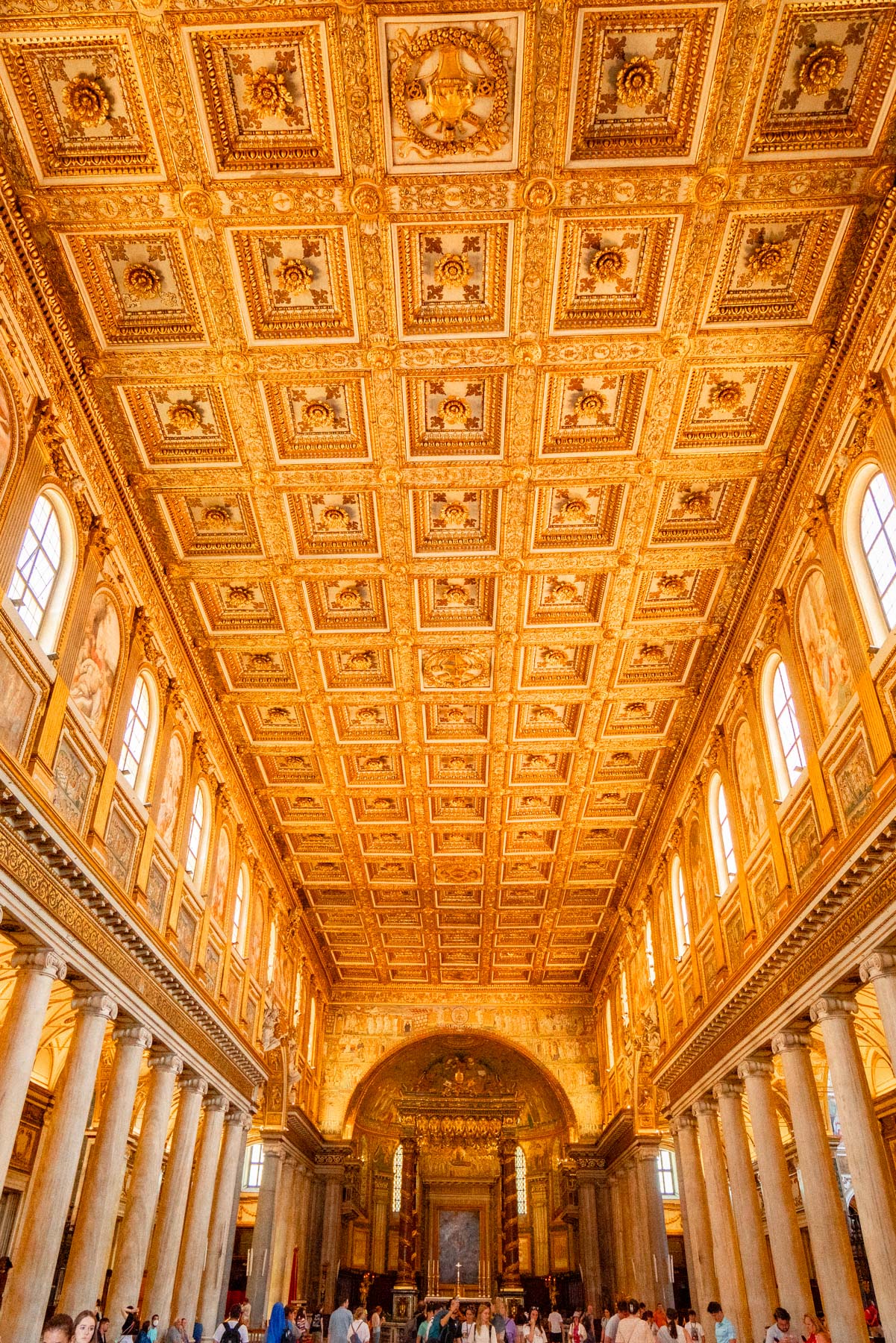
The end result? One of the largest churches in Rome at the time. Heck, it’s still the largest of the 26 churches in Rome dedicated to Mary, the Mother of Jesus. You’ll find monumental columns running down the church’s nave, culminating with a grand apse behind the papal altar.
And speaking of the papal altar, it’s tradition for the Pope to celebrate the Feast of the Assumption of Mary every August 15 at this church in Rome.
Address: P.za di Santa Maria Maggiore, 00100 Roma
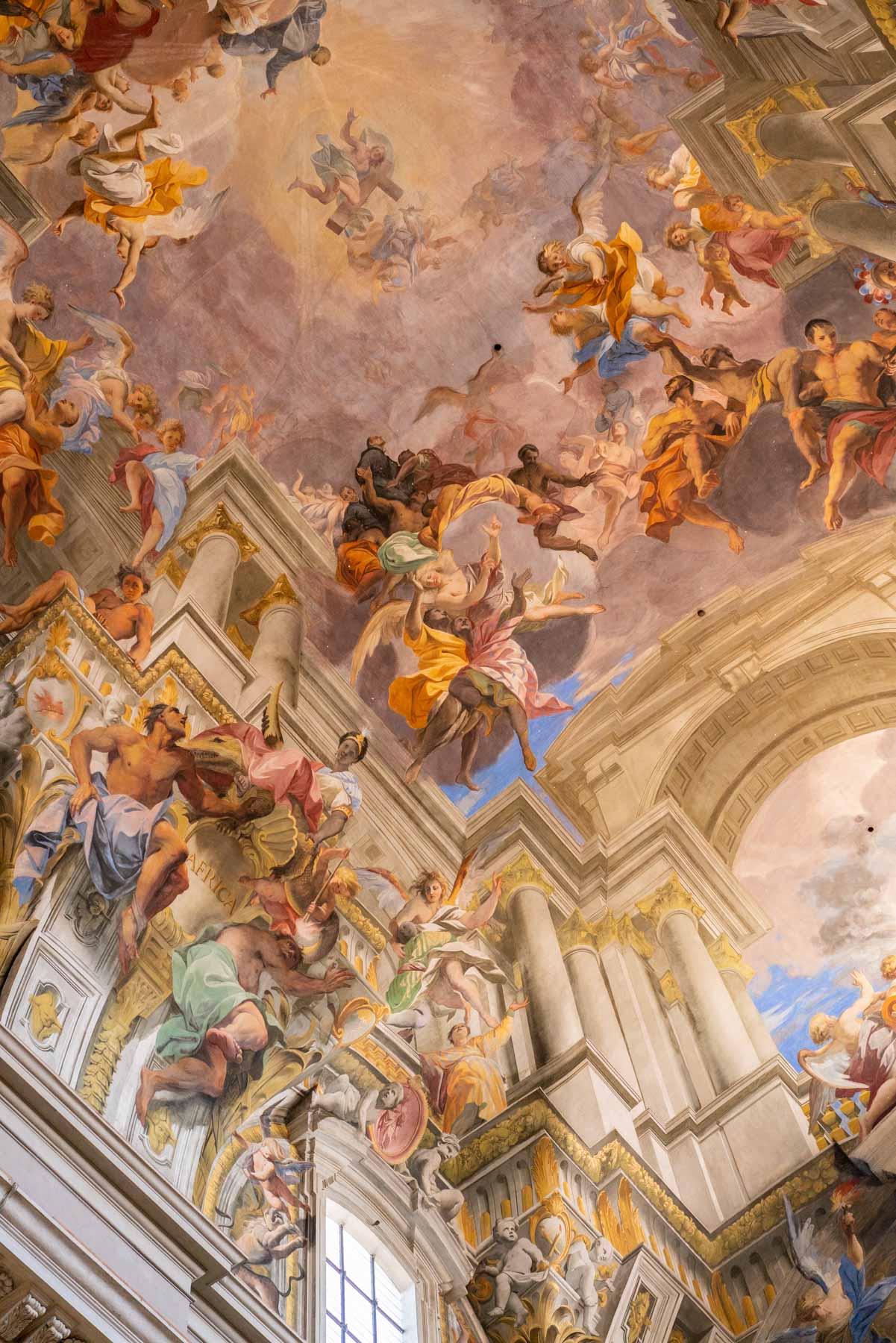
Church of St. Ignatius of Loyola
The Church of St. Ignatius of Loyola is one of my favorite churches in Rome to share with first-time visitors. The first time I saw the ceiling, it nearly took my breath away (it’s impossible to look away).
Founded in the 17th century, the church was dedicated to the founder of the Jesuit order, Ignatius of Loyola. What sets it apart from the other churches in Rome is the magnificent ceiling fresco by Andrea Pozzo.
It’s a trompe-l’oeil marvel that creates the illusion of an open sky and a soaring dome – which, in a delightful twist of creativity, is actually painted on a flat surface due to budget constraints that prevented the construction of a real dome.
The opulent decor and the innovative use of perspective in Pozzo’s fresco offer a unique experience, making the Church of St. Ignatius of Loyola a must-visit for those interested in touring Rome’s most beautiful churches.
Address: Via del Caravita, 8a, 00186 Roma RM
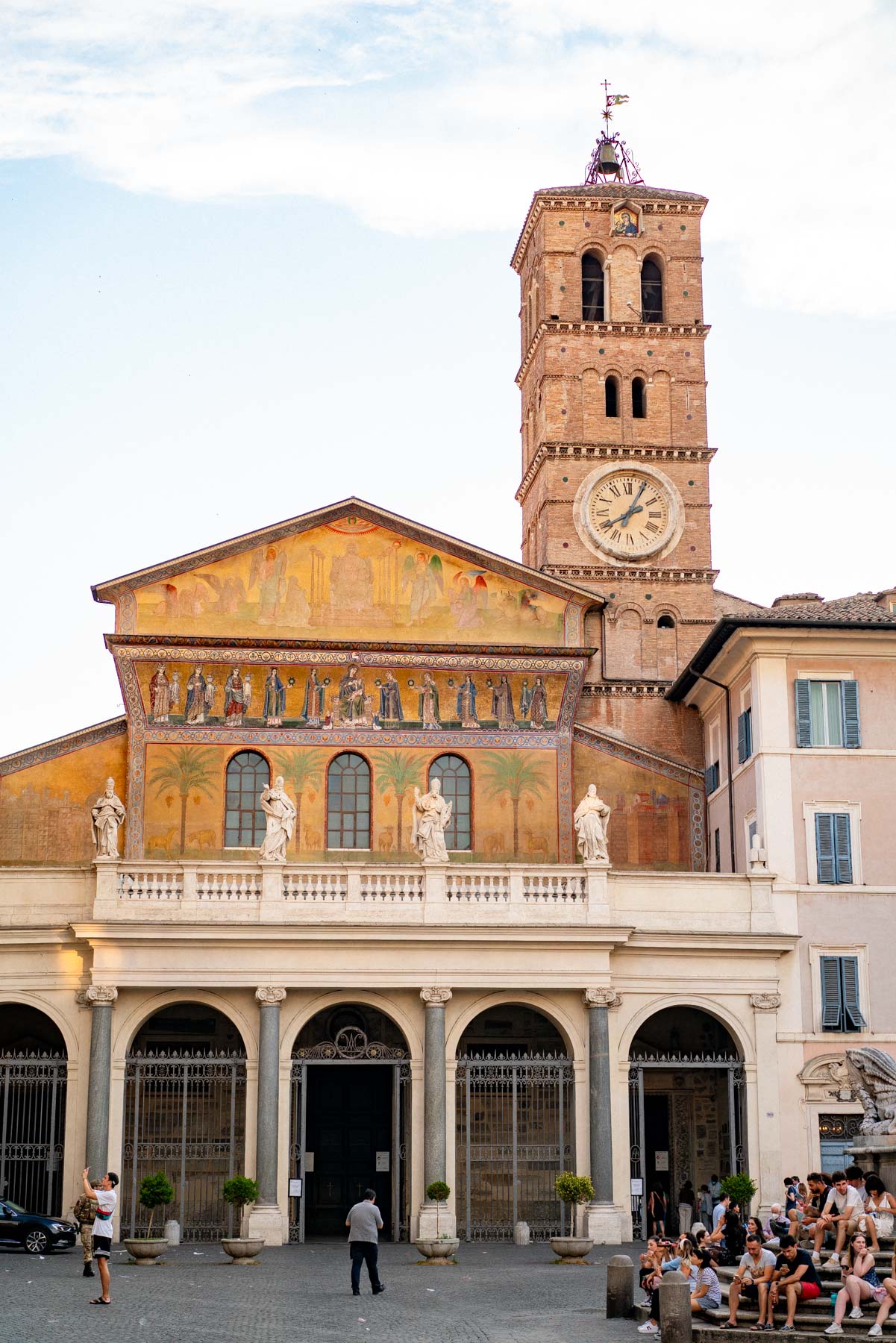
Santa Maria in Trastevere
Dating back to the 3rd century, Santa Maria in Trastevere (Basilica di Santa Maria in Trastevere) is one of the oldest churches in Rome.
Legend has it, the church was founded after oil miraculously sprang from the ground on the site in 38BC, which was interpreted as the announcement of the birth of the Messiah.
People braced for the coming of Christ, which lead to the establishment of a church by Pope Callixtus I. The current structure largely dates from a 12th-century rebuild under Pope Innocent II.
Over the centuries, the church underwent various modifications and restorations, reflecting an interesting mix of evolving architectural styles. The churhc boasts stunning mosaics from the medieval period, including the breathtaking work above the altar that depicts the Virgin Mary nursing Jesus.
Address: Piazza di Santa Maria in Trastevere, 00153 Roma
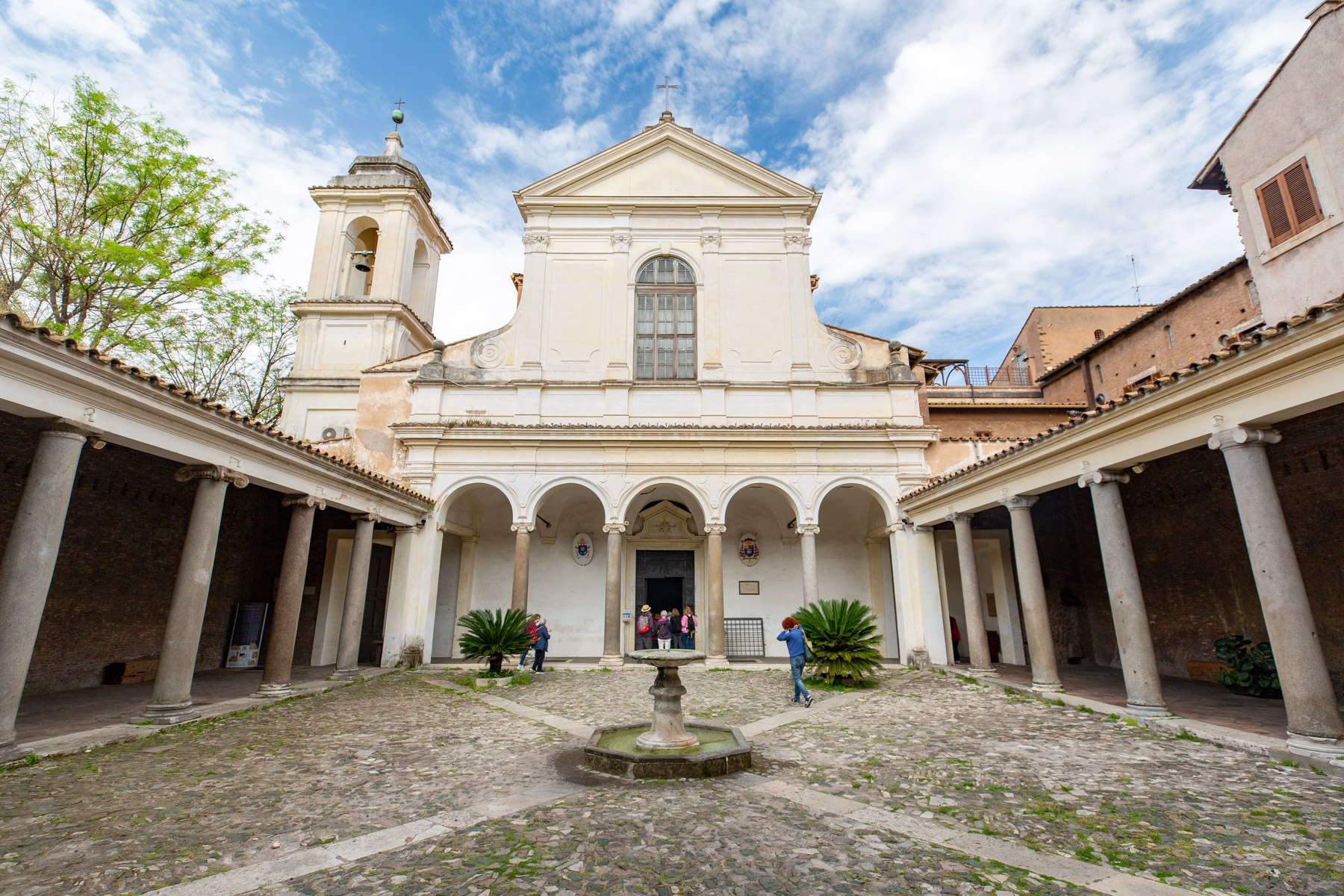
Basilica of St. Clement
The Basilica of St. Clement (Basilica di San Clemente al Laterano) is one of the most unique churches in Rome. What makes this church special is not the stunning interior (full of mosaics and frescoes), but the church’s layered history.
Below the current basilica lie two older layers: a 4th-century basilica and, even further beneath, a 1st-century Roman building and early Christian meeting place. This archaeological complexity provides a tangible connection to Rome’s past, from the early days of Christianity through the Middle Ages to the Renaissance.
The Basilica of St. Clement beautifully encapsulates the evolution of religious and architectural styles in Rome, making it a fascinating and visually stunning destination for those interested in the deep roots of Christian history.
Visiting this church in Rome is free, but accessing its excavations and exploring the breadcrumbs of the previous buildings requires an admission of €10. If you do choose to go underground (which I highly recommend!) you’ll discover catacombs and a glimpse into ancient plumbing, which is kind of cool!
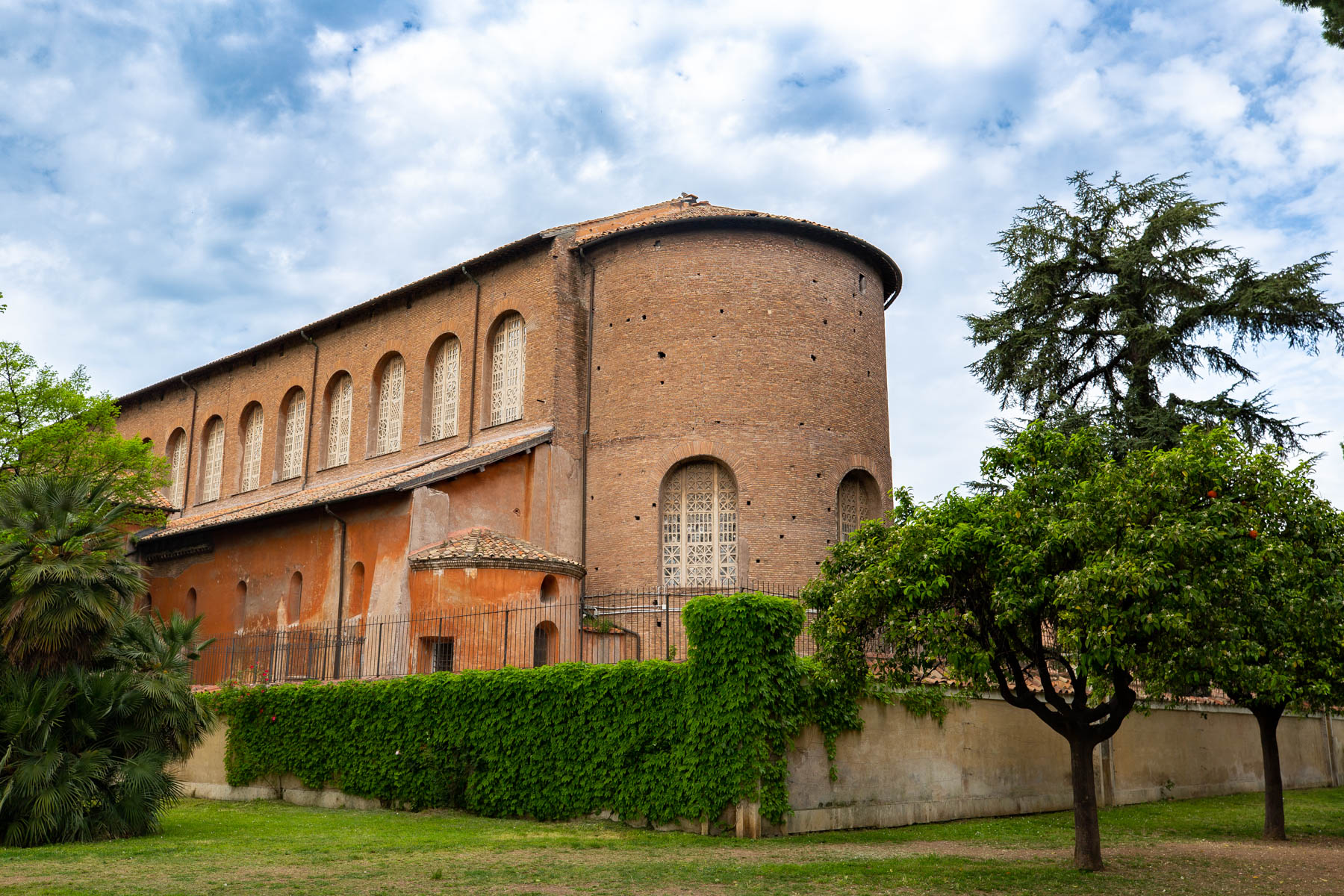
Basilica of Saint Sabina at the Aventine
Perched atop Aventine Hill, the Basilica of Saint Sabina is full of ecclesiastical treasures, offering a glimpse into the early Christian era with its pure architectural design.
Built in 423 AD on the site of Sabina’s house (a martyr of the early Christian Church), this basilica stands as one of the oldest and best-preserved basilicas in Rome. Its beauty lies in its simplicity and the harmonious proportions of the nave and aisles, crowned by a wooden coffered ceiling.
The basilica is also home to the stunning 5th-century wooden doors (made more than 1,500 years ago!), among the oldest in Christian history. This doors feature scenes from the Old and New Testaments, including the first public depiction of the crucifixion of Christ.
In a sea of palatial basilicas, the Basilica of Saint Sabina manages to remain one of the most humble churches in Rome. The basilica lacks the gold accepts and colossal frescoes that marked the Renaissance. So, if you’re looking for one of the best preserved churches in Rome, the Basilica of Saint Sabina should fit the bill.
Address: Piazza Pietro D’Illiria, 1, 00153 Roma RM

Church of St. Louis of the French
The Church of St. Louis of the French is dedicated to the Virgin Mary, St. Denis the Areopagite and St. Louis IX, King of France. It serves as the national church in Rome of France. The church serves as a testament to the friendship between France and Italy.
What makes this Rome church worth a detour are the stunning Caravaggio masterpieces housed within. It’s a collection of three paintings, the “Calling of Saint Matthew,” “The Martyrdom of Saint Matthew,” and “St. Matthew and the Angel.”
Located in the Contarelli Chapel, these paintings highlight Caravaggio’s dramatic use of light and shadow. Beyond the artistic treasures, the church’s elegant architecture and intricate frescoes make it irresistible to architecture buffs.
Address: Piazza di S. Luigi de’ Francesi, 00186 Roma RM
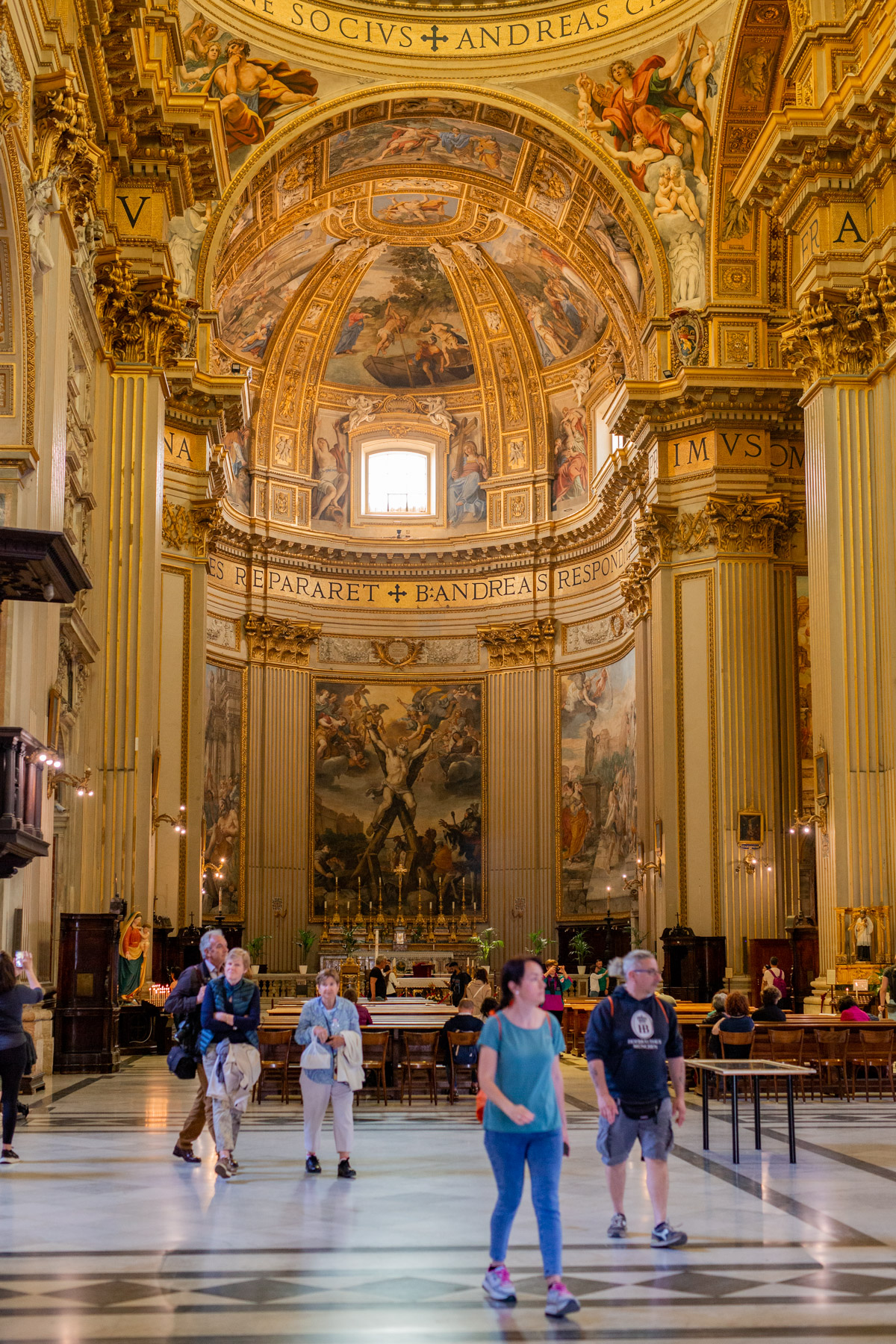
Sant’Andrea della Valle
Renowned for having the second highest dome in the city after St. Peter’s Basilica, Sant’Andrea della Valle is easily one of the most beautiful churches in Rome. Construction began in the late 16th century, spearheaded by the Theatine order, with contributions from some of the era’s most distinguished architects, including Gian Lorenzo Bernini.
The interior is adorned with stunning frescoes, particularly the dome’s glorious frescoes by Lanfranco, and the nave’s intricate designs that tell the stories of St. Andrew’s life. Like many churches in Rome, there is a mirror in the center of the nave to save you from craning your neck.
The church is also significant in that it’s the resting place of two popes, Pope Pius II and Pope Pius III. You’ll also find a chapel (on the right side of the nave) with bronze copies of Michelangelo’s Pieta, Leah, and Rachel from 1616 by Gregorio De Rossi. Although not originals, they manage to leave a lasting impression.
Address: Corso Vittorio Emanuele II, 00186 Roma
Our Lady of the Conception of the Capuchins
The Church of Our Lady of the Conception of the Capuchins dates back to the 17th century. Commissioned by Pope Urban VIII, whose brother, Antonio Barberini, was a Capuchin friar, the church and was established to provide a place of worship for the Capuchin order in Rome.
What makes this one of the most interesting churches in Rome is the eerie yet captivating Capuchin Crypt. A series of small chapels beneath the church which are decorated with the bones of over 4,000 Capuchin monks.
The bones are meticulously arranged to form elaborate decorative patterns and motifs, serving as a stark reminder of the transient nature of life and the inevitability of death.
It’s important to stress that the crypt is not meant to be amusing. It was, and remains, a place for reflection. As you work your way into the last room you’ll find the Crypt of the Three Skeletons where the middle skeleton hold a scythe a scale, talk about thought provoking!
Entrance into the popular Roman Church is free, but access to the Capuchin Crypts is €8.50 per person. Also, photos are not allowed inside.
Address: Via Vittorio Veneto, 27, 00187 Roma
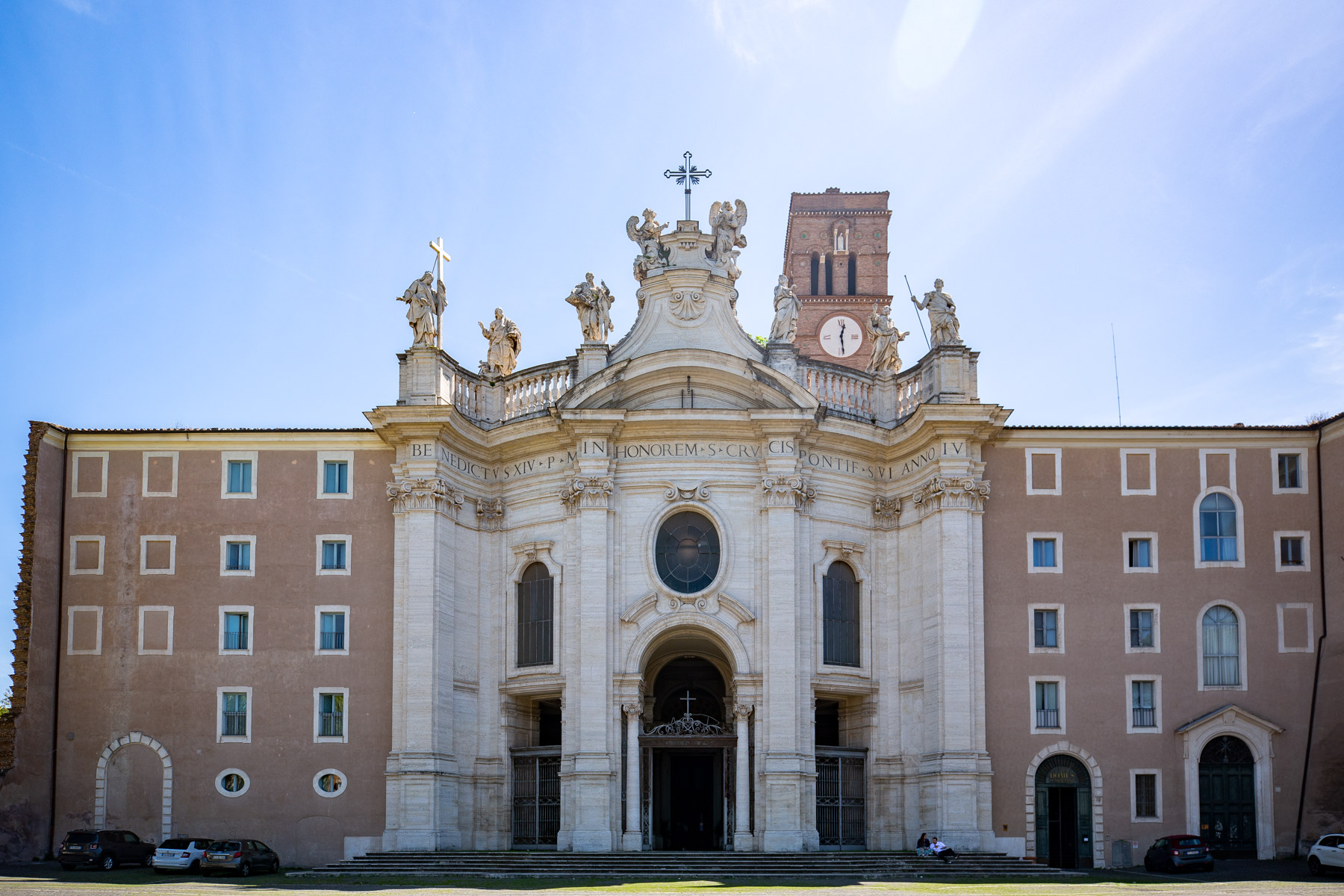
Basilica of the Holy Cross in Jerusalem
The Basilica of the Holy Cross in Jerusalem is steeped in sacred lore. Founded by St. Helena, the mother of Emperor Constantine the Great, the basilica was built to house the relics of the cross that Helena brought back from Jerusalem.
According to tradition, these sacred relics were placed in soil brought from Jerusalem, hence the name “in Jerusalem.” Over the centuries, the basilica has undergone several renovations but continues to stand as a testament to the historical events of Christianity’s roots.
For those visiting the churches in Rome in the hopes of seeing impressive relics, Basilica of the Holy Cross in Jerusalem is a must-see. Significant relics include:
- Fragments of the True Cross
- The Titulus Crucis (inscription placed above Jesus’ head on the cross)
- A nail believed to have been used in the Crucifixion
- Two thrones from the Crown of Thrones
- Part of the scourging column (piece of the pillar to which Jesus was bound and whipped)
- The Holy Sepulchre’s soil (earth from where Jesus was buried)
Address: Piazza di S. Croce in Gerusalemme, 10, 00185 Roma RM
Important Churches in Rome (Post Summary)
In sum, these are the best striking churches and cathedrals in Rome.
- St. Peter’s Basilica
- Archbasilica of Saint John Lateran
- Basilica of Saint Mary Major
- Basilica of Saint Paul Outside the Walls
- Basilica of Saint Peter in Chains
- Basilica of the Holy Cross in Jerusalem
- Our Lady of the Conception of the Capuchins
- Church of St. Louis of the French
- Parish Basilica of Santa Maria del Popolo
- Basilica of Our Lady in Trastevere
- Basilica of Saint Sabina at the Aventine
- Basilica of St. Clement Basilica
- Basilica of St. Stephen in the Round on the Caelian Hill
- Church of St. Ignatius of Loyola at Campus Martius
- Sant’Andrea della Valle
Map of the most beautiful churches in Rome
And there you have it my friends – my roundup of the best churches in Rome. I hope you find the post useful in planning your trip! Let me know if I missed any of your favorites.
Cheers!


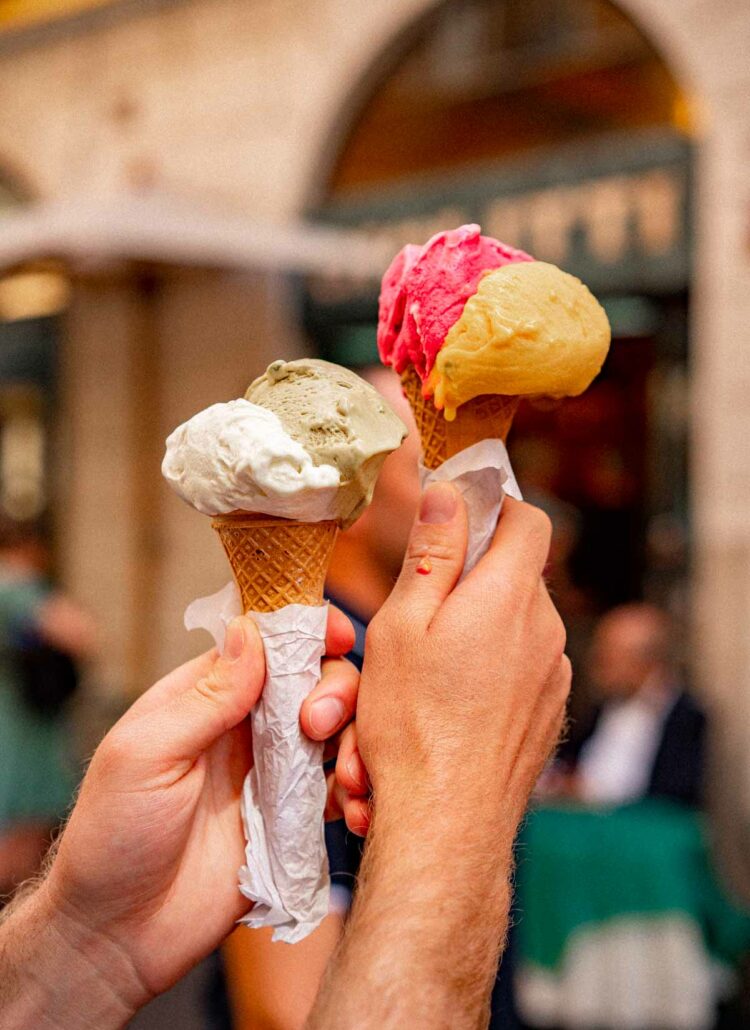
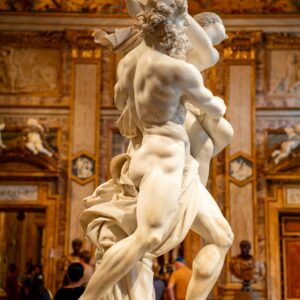
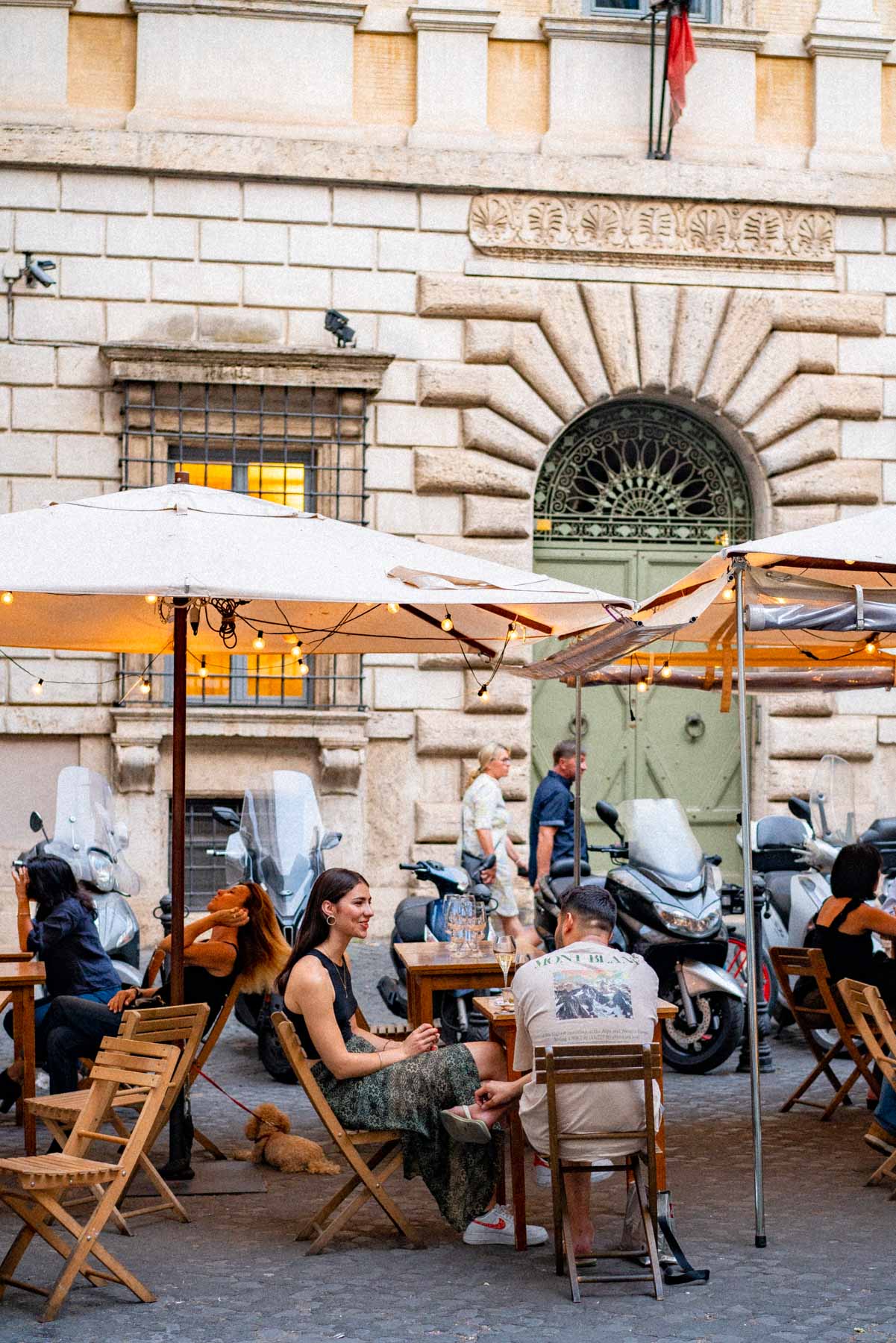
What do you think?